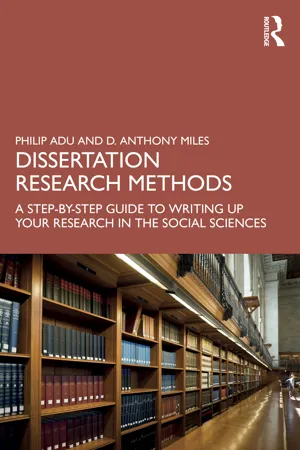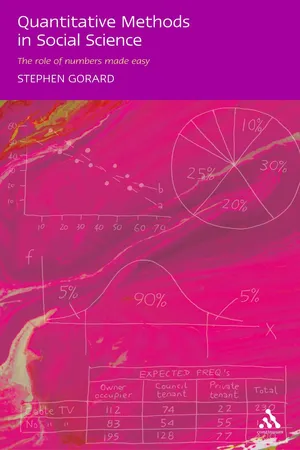Psychology
Population Samples
Population samples refer to a subset of individuals selected from a larger group, or population, to represent the characteristics of that population. In psychology, researchers use population samples to draw conclusions about the broader population based on the characteristics and behaviors of the sample. The goal is to ensure that the sample is representative of the population to make valid inferences.
Written by Perlego with AI-assistance
Related key terms
1 of 5
10 Key excerpts on "Population Samples"
- eBook - PDF
- James B. Schreiber, Kimberly Asner-Self(Authors)
- 2011(Publication Date)
- Wiley(Publisher)
Finally, remember that sampling is a process and method, not simply an end state. Here is to good sampling! POPULATION, SAMPLE, AND PARTICIPANTS The population in social science research refers to all of your potential participants; think of it as the whole group of people in which you are interested. For example, in business, you might be interested in all females aged 35–39; in education, the population could be third-grade students in the continental United States. The sample of participants for your study is part of the population, and all possess some characteristic or characteristics that make them members of the sample group. Those characteristics will have a conceptual or theoretical definition and an operational definition. The conceptual definition uses multiple constructs to create an overall definition, such as socioeconomic status. The operational definition is the specification of that definition, such as income, education level, and job prestige score used as measures for socioeconomic status. A sampling frame is a systematic process to determine the elements from which to sample (i.e., who will be in your final sample from the population). You might initially be interested in all automobile owners as your population; then you might decide to make the first frame female owners and the second frame a specific age group. As sampling frames are applied and the potential sample reduces in size, what one can say about the population as a whole at the end of the study changes. If females aged 35–39 are sampled, at the end of the study the researcher will not be able to talk about males at all or females outside of this age range. If you sample an accessible group of participants from the population of interest, you might have a problem with population validity. Population validity concerns how representative of the population your sample is. - eBook - PDF
What is Psychology?
Foundations, Applications, and Integration
- Ellen Pastorino, Susann Doyle-Portillo, Ellen Pastorino(Authors)
- 2021(Publication Date)
- Cengage Learning EMEA(Publisher)
Because the sample will be used to make inferences or judgments about the entire population, the sample should reflect the whole population as much as possible; that is, it should be a representative sample. Random sampling of participants helps ensure a repre- sentative sample. In a random sample, every member of the population has an equal chance of being selected to participate in the study; this avoids introducing sampling bias into the research. The more representative the sample is, the more the results will generalize (or apply) to the population of interest. But random sampling is not always possible. Instead, psychological research often uses samples of convenience, or groups of people who are easily accessible to the researcher. The students in your psychol- ogy course are a sample of convenience. In fact, much psychological research re- lies on using college students as the sample of convenience! According to Current Population Survey results from the U.S. Census Bureau (2018) around 35% of people in the United States over the age of 25 have a college degree or higher, so samples of college students probably do not represent all types of people and groups. As such, these nonrepresentative samples limit a researcher’s ability to generalize their findings to the population (Levenson, 2017). In addition, online psychology labs at well-known universities across the United States as well as online crowdsourcing platforms, such as Amazon’s Mechanical Turk (MTurk) and TurkPrime, are now much more common ways to recruit partici- pants. On the plus side, researchers conducting online research have the distinct ad- vantage of soliciting a larger and more diverse sample at a fraction of the cost, with improved efficiency and data storage (Gosling & Johnson, 2010; Litman, Robinson, & Abberbock, 2017). Thousands to millions of participants from all over the world may be gathered over the Internet as opposed to a few hundred that can be collected on-site. - eBook - PDF
Research Methods For Business
A Skill Building Approach
- Uma Sekaran, Roger Bougie(Authors)
- 2020(Publication Date)
- Wiley(Publisher)
In research investigations involving several hundreds and even thousands of elements, it would be practically impossible to collect data from, or test, or examine, every element. Even if it were possible, it would be prohibitive in terms of time, cost and other resources. Study of a sample rather than the entire population is also sometimes likely to pro-duce more reliable results. This is mostly because fatigue is reduced and fewer errors therefore result in collecting data, especially when a large number of elements is involved. In a few cases, it would also be impossible to use the entire population to gain knowledge about, or test, something. Consider, for instance, the case of electric light bulbs. In testing the life of bulbs, if we were to burn every single bulb produced, there would be none left to sell! This is known as destructive sampling . INTRODUCTION 222 CHAPTER 14 Sampling In learning how representative data (i.e. as reflected in the universe) can be collected, a few terms, as described below, have first to be understood. POPULATION The population refers to the entire group of people, events or things of interest that the researcher wishes to investigate. It is the group of people, events or things of interest for which the researcher wants to make inferences (based on sample statistics). For instance, if the CEO of a computer firm wants to know the kinds of advertising strategies adopted by computer firms in the Silicon Valley, then all computer firms situated there will be the population. If an organizational consultant is interested in studying the effects of a four-day work week on the white-collar workers in a telephone company in Ireland, then all white-collar workers in that company will make up the population. If regulators want to know how patients in nursing homes run by a company in France are cared for, then all the patients in all the nursing homes run by them will form the population. - No longer available |Learn more
- (Author)
- 2014(Publication Date)
- Orange Apple(Publisher)
In sampling, this includes defining the population from which our sample is drawn. A population can be ________________________ WORLD TECHNOLOGIES ________________________ defined as including all people or items with the characteristic one wishes to understand. Because there is very rarely enough time or money to gather information from everyone or everything in a population, the goal becomes finding a representative sample (or subset) of that population. Sometimes that which defines a population is obvious. For example, a manufacturer needs to decide whether a batch of material from production is of high enough quality to be released to the customer, or should be sentenced for scrap or rework due to poor quality. In this case, the batch is the population. Although the population of interest often consists of physical objects, sometimes we need to sample over time, space, or some combination of these dimensions. For instance, an investigation of supermarket staffing could examine checkout line length at various times, or a study on endangered penguins might aim to understand their usage of various hunting grounds over time. For the time dimension, the focus may be on periods or discrete occasions. In other cases, our 'population' may be even less tangible. For example, Joseph Jagger studied the behaviour of roulette wheels at a casino in Monte Carlo, and used this to identify a biased wheel. In this case, the 'population' Jagger wanted to investigate was the overall behaviour of the wheel (i.e. the probability distribution of its results over infinitely many trials), while his 'sample' was formed from observed results from that wheel. Similar considerations arise when taking repeated measurements of some physical characteristic such as the electrical conductivity of copper. This situation often arises when we seek knowledge about the cause system of which the observed population is an outcome. - eBook - PDF
- Peter H. Rossi, James D Wright, Andy B. Anderson, Peter H. Rossi, James D Wright, Andy B. Anderson(Authors)
- 2013(Publication Date)
- Academic Press(Publisher)
If the employees dislike the new product, or even if they express some reservations, the product is in serious trouble and will probably fail to reach the marketplace. The sample biases are such that one would generally expect employees to be more interested and enthusiastic about a company's new product than would be the general public. If the employees are enthusiastic the product is then tested further on real-world populations. 5.5. D E F I N I N G THE P O P U L A T I O N A sample is most generally defined as a subset from a larger population. This would suggest that before thinking about samples one would already have a clear picture of the universe or population (the terms are used interchange-ably) from which the sample is to be selected. Unfortunately, researchers fre-quently forget to make explicit the universe they wish to study or assume that the universe corresponds to the sample selected. This leads to strange defini-tions of universes such as the universe of all college freshmen in beginning psychology classes, or the universe of readers of a specific magazine or news-paper, when in fact the real universe under study is the total adult population of the United States. It is better to have a clear sensible definition of the target universe and to then carefully describe the sample than to have a misshapen universe definition to fit a strange sample. 5. Applied Sampling 151 The first step in defining a population is to decide whether it is a population of individuals, households, institutions, transactions, or whatever. The source from which the data are to be collected need not be identical to the population definition. If a mail questionnaire is sent to college presidents asking for infor-mation about riots on the campus, the population is of colleges and not of college presidents. - No longer available |Learn more
- (Author)
- 2014(Publication Date)
- Orange Apple(Publisher)
In sampling, this includes defining the population from which our sample is drawn. A population can be ________________________ WORLD TECHNOLOGIES ________________________ defined as including all people or items with the characteristic one wishes to understand. Because there is very rarely enough time or money to gather information from everyone or everything in a population, the goal becomes finding a representative sample (or subset) of that population. Then disseminating. Sometimes that which defines a population is obvious. For example, a manufacturer needs to decide whether a batch of material from production is of high enough quality to be released to the customer, or should be sentenced for scrap or rework due to poor quality. In this case, the batch is the population. Although the population of interest often consists of physical objects, sometimes we need to sample over time, space, or some combination of these dimensions. For instance, an investigation of supermarket staffing could examine checkout line length at various times, or a study on endangered penguins might aim to understand their usage of various hunting grounds over time. For the time dimension, the focus may be on periods or discrete occasions. In other cases, our 'population' may be even less tangible. For example, Joseph Jagger studied the behaviour of roulette wheels at a casino in Monte Carlo, and used this to identify a biased wheel. In this case, the 'population' Jagger wanted to investigate was the overall behaviour of the wheel (i.e. the probability distribution of its results over infinitely many trials), while his 'sample' was formed from observed results from that wheel. Similar considerations arise when taking repeated measurements of some physical characteristic such as the electrical conductivity of copper. This situation often arises when we seek knowledge about the cause system of which the observed population is an outcome. - eBook - PDF
Research Methods For Business
A Skill Building Approach
- Uma Sekaran, Roger Bougie(Authors)
- 2016(Publication Date)
- Wiley(Publisher)
For this purpose, the first 15 people who chose the special item might be interviewed, and their reactions obtained. In such cases, having instant information may be more gainful than obtaining the most representative facts. It should, however, be noted that the results of such convenient samples are not reliable and can never be generalized to the population. THE SAMPLING PROCESS Sampling is the process of selecting a sufficient number of the right elements from the population, so that a study of the sample and an understanding of its properties or characteristics make it possible for us to generalize such properties or characteristics to the population elements. The major steps in sampling include: Low High F I G U R E 1 3 . 3 Normal distribution in a population 240 research methods for business 1. Define the population. 2. Determine the sample frame. 3. Determine the sampling design. 4. Determine the appropriate sample size. 5. Execute the sampling process. Defining the population Sampling begins with precisely defining the target population. The target population must be defined in terms of elements, geographical boundaries, and time. For instance, for a banker interested in saving habits of blue‐collar workers in the mining industry in the United States, the target population might be all blue‐collar workers in that industry throughout the country. For an advertising agency interested in reading habits of elderly people, the target population might be the German population aged 50 and over. These examples illustrate that the research objective and the scope of the study play a crucial role in defining the target population. Determining the sample frame The sampling frame is a (physical) representation of all the elements in the population from which the sample is drawn. The payroll of an organization would serve as the sampling frame if its members are to be studied. - eBook - PDF
Research Methods For Business
A Skill Building Approach
- Roger Bougie, Uma Sekaran(Authors)
- 2021(Publication Date)
- Wiley(Publisher)
Note that the sample size will, therefore, at least partly, depend on the heterogeneity of the population. Awareness of sampling designs and sample size helps managers to understand why a particular method of sampling is used by researchers. It also facilitates understanding of the cost implica- tions of different designs, and the trade-off between precision and confidence vis-à-vis the costs. This enables managers to understand the risk they take in implementing changes based on the results of the research study. While reading research reports or journal articles, this knowledge also helps managers to assess the generalizability of the findings and analyse the implications of trying out the recommendations made therein in their own system. • Learning objective 1: Define sampling, sample, population, element, sampling unit and subject. In learning how representative data can be collected, a few terms have to be understood. The popu- lation refers to the entire group of people, events or things of interest that the researcher wishes to investigate. An element is a single member of the population. A sample is a subset of the population. The sampling unit is the element or set of elements that is available for selection in some stage of the sampling process. A subject is a single member of the sample, just as an element is a single member of the population. • Learning objective 2: Discuss statistical terms in sampling. Sampling units provide the researcher with responses. When researchers examine the responses they get for their entire sample, they make use of statistics. The characteristics of the population are referred to as its parameters. When the properties of the population are not overrepresented or underrepresented in the sample, we have a representative sample. • Learning objective 3: Describe and discuss the sampling process. - eBook - ePub
Dissertation Research Methods
A Step-by-Step Guide to Writing Up Your Research in the Social Sciences
- Philip Adu, D. Anthony Miles(Authors)
- 2023(Publication Date)
- Routledge(Publisher)
Sampling is frequently employed to estimate the sizes of populations, groups and other types of populations. The practice of sampling has so many more uses for research. When researchers gather information obtained from properly selected populations, it can give rise to an interesting sample. The researcher must remember that the sample is selected from the sampling frame, which is a list of all the units from a population to be surveyed. Consider that the sampling frame will contain all the units of the population under consideration, which includes the target population. For example, many qualitative methods texts offer valuable types of sampling methods. Consider the theoretical sampling method. This aspect of theoretical sampling refers to data gathering directed by emerging concepts. With theoretical sampling, the researcher follows the process of the trailing of concepts, looking for sites, persons or events that will enable further comparisons of data.In this chapter, we provide an introduction to many elements associated with sampling methods and define the basic terminology and underlying principles of sampling. The chapter goes on to explain sampling strategies and approaches to both quantitative and qualitative methodologies. The chapter also provides an introduction to sampling techniques to identify the differences between groups and populations.Population, Sampling and Definitions
There are different terms that need to be introduced before we get into the finer points of sampling. There are some terms and definitions that need to be underscored.A population is defined as an aggregate of units such as people, households, cities, districts, countries, states or provinces. It is also an entire group of people, events or things of interest that the researcher wishes to investigate (Rao, 2000 ; Upton & Cook, 2008 ; Sekaran & Bougie, 2013 ; Yaremko et al., 2013 ). A population under investigation depends on the nature of the investigation. A population may be homogenous or heterogeneous. A population can be homogenous when its every element is similar to each other in all aspects and when its elements are not similar to each other in all aspects. The variables that make a population heterogeneous can vary greatly from research to research. Common variables that make a population heterogeneous are gender, age, ethnicity, socioeconomic status and so on (Zedeck, 1986 ; Alvi, 2016 - Stephen Gorard(Author)
- 2003(Publication Date)
- Continuum(Publisher)
If any other method of selecting a sample is used, standard techniques of statistical analysis are inappropriate (Lee et al. 1989). One apparent deviation from this principle of equal/proportion-ate probability of selection is where a boosted sample is used. In this design, the probability of selection is boosted for some rare sub-groups to ensure that sufficient of them are obtained for a comparison to be made (black ethnic groups in northern Scotland might be a current example of a rare sub-group, usually insufficiently represented in a regional poll for any serious analysis to proceed). This approach is valuable and perfectly valid as long as the then over-represented cases are re-weighted (see below). A classic problem in sampling comes from bias through the use of Volunteers'. Whether you provide an incentive for participants or use captive subjects, it is quite clear that those who are willing to devote an afternoon to taking part in your study could be very different from those who are not. Captive subjects are those forced to take part. On many university psychology courses, for example, undergraduates are required to sign a contract agreeing to take part in a certain number of studies as a condition of their acceptance. This can understandably lead to many problems such as sullenness and even the outright sabotage of experiments. At best it means that much of what psychology tells us applies only to the population of captive psychology undergraduates, and beyond specific groups does not have much external validity. Nineteenth-century psychol-ogy was often based on what researchers found out about themselves (introspection), while later twentieth-century psychology was chiefly based on what psychologists found out about each other. There are some hopeful signs that in the twenty-first century psychology is becoming more concerned with people at large.
Index pages curate the most relevant extracts from our library of academic textbooks. They’ve been created using an in-house natural language model (NLM), each adding context and meaning to key research topics.









